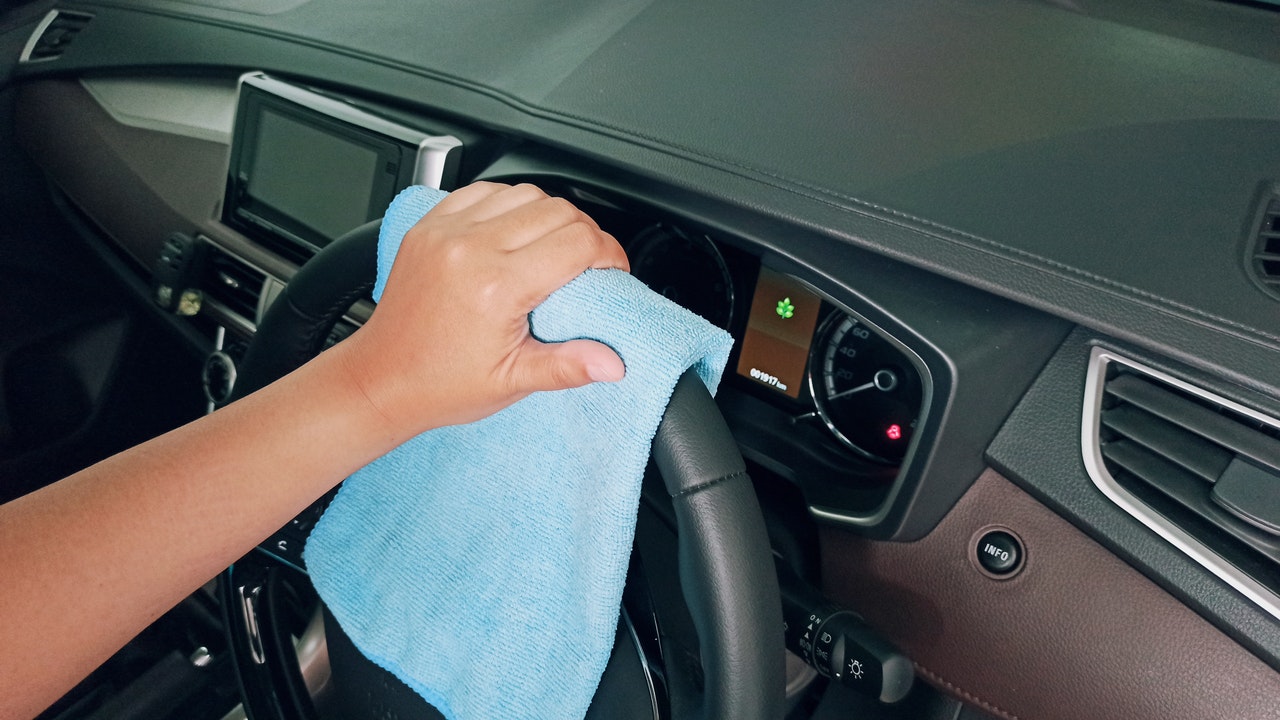Have you ever been on the road, ready to take on the day, only to find that your steering wheel feels sticky and unpleasant? It’s more than just a minor inconvenience—it can be downright distracting and even unsafe.
Imagine driving with your hands slipping or struggling to keep a firm grip. It’s not just annoying; it can make you anxious every time you get behind the wheel. The good news is that fixing a sticky steering wheel is easier than you might think.
In this guide, you’ll discover quick and effective solutions to restore your steering wheel to its original smooth state. Say goodbye to the frustration and hello to a more comfortable driving experience. Ready to learn how? Let’s dive in!

Credit: downtownautobody.com
Common Causes Of Sticky Steering Wheels
Grime, spilled drinks, and worn-out steering wheel covers often cause sticky steering wheels. Regular cleaning and maintenance can usually resolve this issue, ensuring smooth and comfortable driving.
When your steering wheel starts to feel sticky, it can turn even the simplest drive into a frustrating experience. Identifying the root cause is crucial for a smooth ride. Let’s dive into some common reasons why your steering wheel might be sticking and how you can address them.1. Accumulation Of Dirt And Grime
Over time, dirt and grime can build up on your steering wheel. Think about all the times you’ve grabbed the wheel with sticky hands or after eating. This residue can cause the wheel to feel sticky and uncomfortable. Regular cleaning with mild soap and water can prevent this accumulation.2. Spilled Beverages And Food
Accidental spills are common, especially if you snack or drink while driving. Sugary drinks and greasy foods can leave a stubborn residue on the steering wheel. If you’ve ever spilled soda or coffee, you know how quickly it can create a sticky mess. Keeping a pack of wet wipes in your car can help you tackle spills immediately.3. Environmental Factors
Your car’s interior is subject to various environmental factors. High humidity can cause materials to become tacky, especially if your car is parked in direct sunlight. This can make your steering wheel feel sticky to the touch. Using a sunshade can help maintain a cooler, less humid environment inside your vehicle.4. Worn Or Damaged Steering Wheel Cover
A worn-out steering wheel cover can contribute to stickiness. Over time, the material can degrade, leaving a sticky residue on your hands. Inspect your steering wheel cover for any signs of wear and tear. Replacing it can instantly improve your driving experience.5. Chemical Reactions
Certain cleaning products can react with the materials of your steering wheel. This can lead to a sticky feeling. Are you using the right products for your car’s interior? Always check the label and ensure compatibility to avoid unwanted reactions. Addressing these causes can transform your driving experience from frustrating to enjoyable. Have you identified the culprit behind your sticky steering wheel? Give these solutions a try and notice the difference.Cleaning The Steering Wheel Surface
Cleaning the steering wheel surface helps fix a sticky steering wheel. Gently scrub with a mild cleaner and soft cloth to remove grime. Rinse and dry thoroughly to avoid residue.
Cleaning the steering wheel surface is a crucial step in fixing a sticky steering wheel. Over time, dirt, grime, and sweat accumulate, making it uncomfortable and unhygienic. The good news is that with some simple cleaning methods, you can restore your steering wheel to its original smooth feel.Using Soap And Water
Start with the basics: a simple mix of soap and water. It’s effective and gentle on most steering wheel materials. Use a soft cloth or sponge to apply the soapy solution. Gently scrub the steering wheel, focusing on areas where dirt buildup is most noticeable. Rinse the cloth and wipe down the wheel to remove any soap residue. Don’t forget to dry it thoroughly with a clean towel to prevent any water spots. You might be surprised by how much grime this simple method can remove.Applying Vinegar Solution
A vinegar solution is a great natural alternative for cleaning. Mix equal parts of white vinegar and water in a spray bottle. Spray it onto the steering wheel and let it sit for a minute. Use a cloth to wipe away the solution, along with the grime. Vinegar not only cleans but also helps in disinfecting the surface. Plus, it’s a budget-friendly option that many people already have at home.Commercial Cleaning Products
If you’re dealing with stubborn stains, commercial cleaning products might be the answer. Look for products specifically designed for car interiors. Always read the instructions to ensure it’s safe for your steering wheel material. Apply the cleaner as directed, using a microfiber cloth to avoid scratching. It’s amazing how a product tailored for the job can make such a difference. Have you ever tried a new cleaner and been thrilled with the results? Sometimes, investing in the right product can save you time and effort. By choosing the right cleaning method, you’ll not only fix that sticky steering wheel but also enjoy a more pleasant driving experience. Which method will you try first?Conditioning The Steering Wheel
Sticky steering wheels can be fixed by cleaning and conditioning. Use mild soap and water to remove grime. Apply a leather conditioner to keep the steering wheel smooth and prevent stickiness. Regular maintenance enhances driving comfort and preserves wheel quality.
Is your steering wheel sticking and making driving less enjoyable? Conditioning the steering wheel can be a simple and effective solution. By giving your steering wheel some much-needed care, you can restore its functionality and appearance. Whether your steering wheel is made of leather, plastic, or rubber, proper conditioning can prevent further wear and tear, enhancing your driving experience. Let’s dive into how you can condition different types of steering wheels to keep them in top shape.Leather Conditioning
Leather steering wheels add a touch of luxury to your car. However, they require regular maintenance to prevent them from getting sticky and uncomfortable. Start by cleaning the leather with a mild soap and water solution. Use a soft cloth to gently scrub the surface, removing any dirt or grime. Once clean, apply a quality leather conditioner. This helps to keep the leather supple and prevents it from drying out and cracking. Be generous with the conditioner, but avoid over-saturating the leather. Let it sit for a few minutes, then buff the wheel with a clean cloth until it’s dry. Have you ever noticed how a well-conditioned leather jacket feels? Your steering wheel can feel the same way—smooth and inviting.Plastic And Rubber Care
Plastic and rubber steering wheels are often more durable but still need care to maintain their texture and grip. Begin by wiping the surface with a damp cloth to remove dust and debris. A mixture of water and vinegar can be an effective cleaner for these materials. After cleaning, use a plastic or rubber conditioner spray. These conditioners restore the original shine and prevent the material from becoming brittle. Spray a small amount onto a clean cloth and rub it into the steering wheel evenly. Imagine the satisfaction of a smooth, non-sticky wheel as you drive down the highway. It’s a small change that makes a big difference. How often do you condition your steering wheel? Regular care not only keeps it looking good but also extends its life, making every drive a pleasure. By taking these simple steps, you can enjoy a more comfortable and safe driving experience.
Credit: www.reddit.com
Preventing Future Stickiness
A sticky steering wheel is frustrating. It can also be unsafe. Keeping it in good condition is crucial. Regular care helps prevent stickiness. It saves time and money. Plus, it keeps driving enjoyable. Here’s how to maintain your steering wheel and avoid future problems.
Regular Maintenance Tips
Clean the steering wheel weekly. Use a gentle cleaner. A microfiber cloth works best. This removes dirt and grime. Avoid scrubbing too hard. It can damage the material. Always dry the wheel after cleaning. Moisture can lead to stickiness.
Inspect the wheel monthly. Look for signs of wear. Check for cracks or tears. Repair any damage promptly. This prevents further problems. Regular inspection keeps your wheel in top condition.
Avoiding Certain Products
Some products harm the steering wheel. Avoid harsh chemicals. They can cause stickiness. Choose cleaners designed for car interiors. These are gentler and safer.
Steer clear of oily products. They leave a residue. This makes the wheel slippery and sticky. Stick to water-based products. They’re less likely to cause issues.
Also, avoid excessive use of conditioners. They can build up over time. This buildup causes stickiness. Use conditioners sparingly. Follow the manufacturer’s instructions.
Professional Help Options
A sticky steering wheel can be more than just a nuisance. It can affect your driving experience and safety. While DIY solutions are available, sometimes professional help is necessary. Experts use specialized tools and techniques to clean and fix steering wheels. This ensures your wheel is smooth and responsive. Let’s explore when professional assistance might be needed and the costs involved.
When To Seek Expert Assistance
Consider professional help if the stickiness persists after cleaning. This may indicate a deeper problem. Experts can diagnose and fix these issues promptly. They have the experience to handle complex steering mechanisms. If your steering wheel feels unsafe or unreliable, seek expert help. It’s better to be safe than sorry.
Costs And Benefits Of Professional Cleaning
Professional cleaning services vary in price. Costs depend on the service provider and your car model. Generally, prices range from $50 to $150. Paying for professional help can save time and ensure thorough cleaning. Professionals offer guaranteed results. A clean steering wheel improves driving comfort and safety. Investing in professional help can be a wise choice.

Credit: www.youtube.com
Conclusion
Fixing a sticky steering wheel doesn’t have to be hard. Start by cleaning the wheel with mild soap and water. This removes dirt and grime. If the stickiness persists, try a specialized cleaner. Ensure to dry the wheel thoroughly. Regular maintenance prevents future issues.
Check for any underlying mechanical problems too. A smooth steering wheel enhances driving comfort. It also ensures safety on the road. Keep your vehicle in top condition. A few simple steps make a big difference. Enjoy a better driving experience every time.
Stay safe and drive smoothly.
